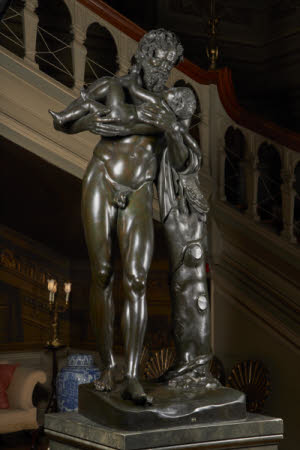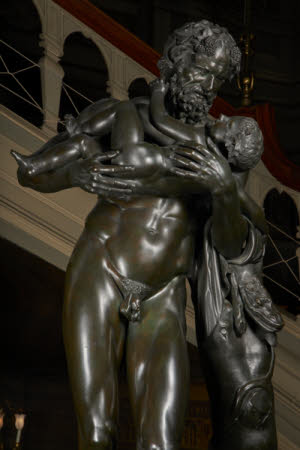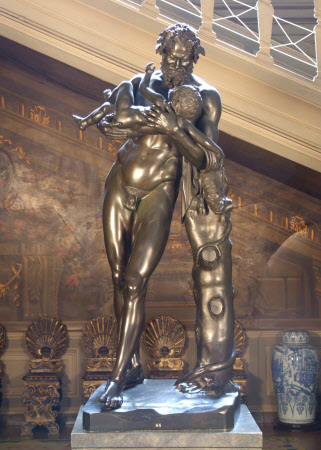Silenus holding the Infant Bacchus
French School
Category
Art / Sculpture
Date
1808 - 1835
Materials
Bronze
Measurements
1980 mm high
Place of origin
France
Order this imageCollection
Petworth House and Park, West Sussex
NT 485298
Summary
Bronze sculpture, Silenus holding the Infant Bacchus, French School, early 19th century. A bronze copy of the Imperial Roman marble statue group in the Louvre, Paris, discovered in Rome about 1569 and purchased in 1807 by Napoleon from the Villa Borghese, Rome. This copy, brought by the 3rd Earl, stood in 1835 at the centre of the South Corridor of the North Gallery. An engraving published in 1594 states that (the original) of this statue was in the collection of Carlo Muti who, according to Flaminio Vacca, writing in the same year or earlier, had discovered it together with the Borghese Vase at his estate near the present Casiuno Massimo, part of the site of the gardens of Sallust and this must have been before 18 September 1569 when Cardinal Ferdinando de' Medici wrote to Carlo Muti thanking him for permission to have his Faun moulded. The statue is described by Francucci as in the Borghese collection in 1613; it was in the Villa Borghese by 1638, and by 1650 was in a room there named after it. The 'Silenus' was purchased on 27 September 1807, together with the bulk of the Borghese antiquities, by Napoleon Bonaparte, brother-in-law of Prince Camillo Borghese. It was sent from Rome between 1808 and 1811 and was recorded in the latter year in the Salle d'Apollon in the Musee Napoleon. By 1815 it was in a room named after it. The 'Silenus' was one of the most consistently admired antique statues in Rome both for the quality of the design and the charming sentiment. It was classed on occasion with the 'Venus de'Medici', the 'Farnese Hercules' and the 'Antinous' and it was frequently reproduced. The Sileni were originally spirits of wild nature rather like satyrs, but by the 6th century BC Silenus appears on the Francois Vase as a bearded man with horse-ears, and he becomes associated with the god Dionysus (Roman Bacchus) and is sometimes said to have been his tutor. He possesses special knowledge and wisdom which is inspired by wine drinking, and therefore he is generally drunk. ,
Provenance
Bought by the 3rd Earl of Egremont. By descent, until the death in 1952 of the 3rd Lord Leconfield, who had given Petworth to the National Trust in 1947, and whose nephew and heir, John Wyndham, 6th Lord Leconfield and 1st Lord Egremont (1920-72) arranged for the acceptance of the major portion of the collections at Petworth in lieu of death duties (the first ever such arrangement) in 1956 by H.M.Treasury.
Marks and inscriptions
88 (painted in white on base)
Makers and roles
French School, sculptor
References
Haskell and Penny 1981: Francis Haskell and Nicholas Penny, Taste and the Antique, The Lure of Classical Sculpture 1500 - 1900, New Haven and London, 1981, 77




